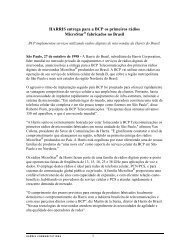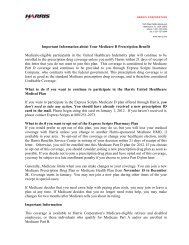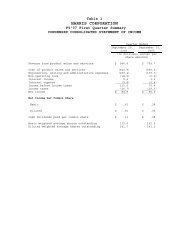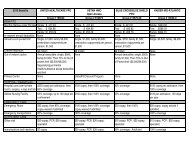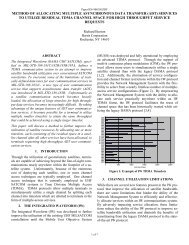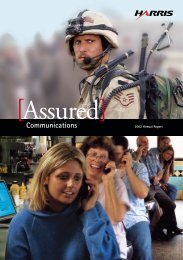ASSURED COMMUNICATIONS
ASSURED COMMUNICATIONS
ASSURED COMMUNICATIONS
You also want an ePaper? Increase the reach of your titles
YUMPU automatically turns print PDFs into web optimized ePapers that Google loves.
4<br />
Government Communications Systems<br />
Division (GCSD)<br />
Harris GCSD continued to solidify its position in fiscal 2003<br />
as a leader in mission-critical, assured communications<br />
and information systems and components, image processing,<br />
and systems integration and services. Revenue<br />
and profitability growth were excellent.<br />
GCSD is supporting the U.S. Department of Defense and<br />
other government agencies as they design and deploy new<br />
aircraft, satellite and weapons platforms, and integrated<br />
communications networks. The necessity for secure voice,<br />
data and video communications network architectures has<br />
never been greater. We have secured positions on a number<br />
of long-term, strategic programs for the U.S. Government<br />
that are expected to be significant revenue drivers for many<br />
years to come. These include:<br />
• F/A-22 Raptor and F-35 Joint Strike Fighter aircraft,<br />
and RAH-66 Comanche reconnaissance/attack<br />
helicopter programs<br />
• FAA Telecommunications Infrastructure program<br />
• Census Bureau MAF/TIGER ® During fiscal 2003, RFCD responded to customer<br />
requirements in Iraq and Afghanistan, and also supported<br />
U.S. troops on a number of other important security<br />
missions around the globe. In addition, we shipped radios<br />
to over 40 international customers. Nowhere else is the term<br />
“mission-critical” more<br />
appropriate than on<br />
the battlefield, and our<br />
family of Falcon<br />
database management<br />
program<br />
• Space-Based Radar program for the U.S. Air Force<br />
• Mission Communication Operations and Maintenance<br />
for the Air Force satellite network<br />
• Global Geospatial Intelligence program for the<br />
National Imagery and Mapping Agency<br />
We also are working with renewed commitment to<br />
transfer advanced technologies developed for government<br />
applications into our commercial businesses. Technology<br />
transfer at Harris will allow our commercial businesses to<br />
leapfrog competition with highly innovative products and<br />
system solutions.<br />
RF Communications Division (RFCD)<br />
Harris RFCD had an outstanding year with<br />
record revenue and profitability. The business<br />
continues to benefit from its well-earned reputation<br />
as the most reliable and responsive<br />
supplier of secure, tactical HF and multiband<br />
radios to the U.S. military and our allies.<br />
® II<br />
radios has performed<br />
at the highest level.<br />
RFCD continued<br />
to support homeland security initiatives. Through the<br />
Defense Early Response Fund, Harris tactical radios are<br />
being used to equip the U.S. National Guard and other<br />
agencies that provide quick response in times of national<br />
emergencies. RFCD also strengthened its position as a<br />
major contributor to next-generation tactical radio programs<br />
for both the U.S. Department of Defense and the<br />
UK Ministry of Defence. Harris was recently selected to<br />
incorporate its Sierra™ RF Communications<br />
Falcon<br />
cryptographic subsystem into 100<br />
percent of the radios to be provided to the Department of<br />
Defense under Cluster 1 of the U.S. Joint Tactical Radio<br />
System program.<br />
Broadcast Communications Division (BCD)<br />
Harris BCD is the recognized industry leader in the transition<br />
to digital television (DTV) and digital radio technology. With<br />
the most complete array of solutions encompassing transmitters,<br />
network devices, automation software, support<br />
services, and studio systems integration, customers turn to<br />
Harris for expert advice and support. Over 600 network<br />
affiliates and public broadcast television stations have<br />
already installed digital transmission systems from BCD.<br />
Fiscal 2003 proved financially challenging<br />
at BCD due to several market factors. First,<br />
uncertainty surrounding the timing of full<br />
broadcast conversion to DTV delayed new<br />
investments. The Federal Communications<br />
Commission has just recently proposed a<br />
mandate requiring stations in major markets<br />
® II<br />
Bowman Programme<br />
JTRS Cluster 1<br />
Government<br />
Communications<br />
Avionics & space systems<br />
Comm & info systems<br />
Information technology<br />
services




